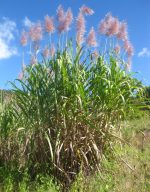 Native to tropical southeast Asia, this tender perennial grass is a member of the Poaceae/Gramineae family that also includes corn, wheat, rice, and bamboo. The plants from a network of rhizomes that produce arching clumps up to 15′ tall. The smooth glossy canes are unbranched, jointed, and have internodes filled with pith that is immersed in a sugary sap. The linear strap-shaped leaves are up to 5′ long and have a prominent midrib and toothed margins. In the fall flowers appear in fluffy pinkish pannicles up to 24″ long. The single seeded fruits are dry. Sugar cane has been grown for about 8000 years and has given rise to many cultivars that vary most significantly in height, cane color, leaf color and hardiness. It is a good choice for a screen or windbreak in warm climates and grows well in a container. Both flowers and leaves are attractive in fresh and dried arrangements. The genus name, Saccharum, is from the Greed word sakcharon meaning the sweet juice of the sugar cane. The specific epithet, officinarum, is the Latin word meaning of shops and usually refers to apothecaries.
Native to tropical southeast Asia, this tender perennial grass is a member of the Poaceae/Gramineae family that also includes corn, wheat, rice, and bamboo. The plants from a network of rhizomes that produce arching clumps up to 15′ tall. The smooth glossy canes are unbranched, jointed, and have internodes filled with pith that is immersed in a sugary sap. The linear strap-shaped leaves are up to 5′ long and have a prominent midrib and toothed margins. In the fall flowers appear in fluffy pinkish pannicles up to 24″ long. The single seeded fruits are dry. Sugar cane has been grown for about 8000 years and has given rise to many cultivars that vary most significantly in height, cane color, leaf color and hardiness. It is a good choice for a screen or windbreak in warm climates and grows well in a container. Both flowers and leaves are attractive in fresh and dried arrangements. The genus name, Saccharum, is from the Greed word sakcharon meaning the sweet juice of the sugar cane. The specific epithet, officinarum, is the Latin word meaning of shops and usually refers to apothecaries.
Type: Tender perennial grass
Bloom: Fluffy pinkish pannicles up to 24″ long in the fall
Size:15′ H
Light:Full sun
Soil: Fertile, moderately moist, well-drained
Hardiness: Zones 9-10
Care: Fertilize with balance fertilizer.
Pests and Diseases: None of significance
Propagation: Seed, division or cuttings of mature canes
Photo Credit: Wikipedia